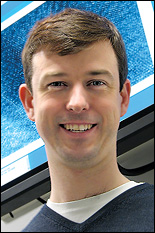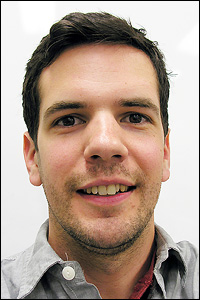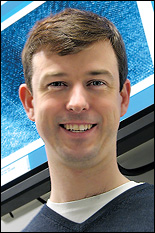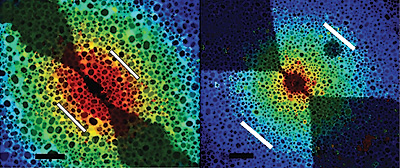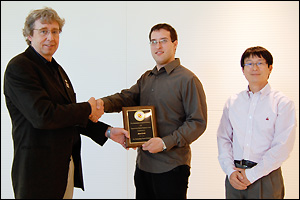News Story
Cumings, Seog Win NSF CAREER Awards for Nanotechnology Research
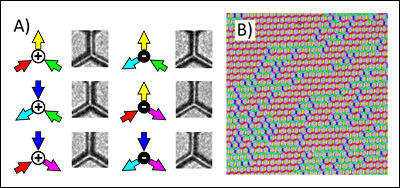
Above: From Professor John Cumings' research: Electron microscopy shows the interaction of artificial magnetic atoms on an experimentally-defined lattice. A) various configurations of the interacting vertices, showing magnetic monopoles at the intersections. B) Under the influence of a magnetic field, monopoles move through the lattice, producing reversal patterns that will be studied in the course of Cumings' research project. See below for an animation demonstrating the optical mini tweezers used in Professor Joonil Seog's research.
Proposals to study misbehaving crystals and peptides that spin themselves into nanofibers have earned two Department of Materials Science and Engineering professors National Science Foundation (NSF) Faculty Early Career Development (CAREER) Awards.
Assistant professors John Cumings and Joonil Seog, who were recognized by the NSF as outstanding junior faculty who most effectively integrate research and education, will each receive a grant of at least $500,000 to support their research.
Cumings received his award for a proposal titled "Frustration on Nanomagnetic Lattices." When liquids become solids, their atoms usually lock into a perfect, repeating pattern—a unique crystal configuration known as a ground state. However, some materials can simultaneously settle into many possible crystal structures, resulting in an imperfect solid made of disordered arrangements of different patterns. Materials with these unusual properties are referred to as "frustrated." Cumings' goal is to study the fundamental aspects and causes of frustration in artificial materials, and to determine if nanoscale magnets with frustrated molecular structures can be encouraged to overcome their nature and align themselves into repeating patterns.
"One of the interesting things about this project is that even if we can't overcome these materials' frustration, it would be very good news for magnetic memory technology, which relies on the fact that certain patterns of magnetic bits do not find a unique ground state," he explains. "Our custom-designed magnetic nanomaterials could potentially achieve much higher information density than conventional memory because we could pack more bits into the same space."
Cumings' CAREER award will also fund a team of early career scientists, a postdoctoral researcher and a graduate student to work on the project, as well as a pre-college student recruited from an area high school. The research will be conducted in the Nanoscale Imaging, Spectroscopy, and Properties Laboratory (NISPLab).
Seog (joint, Fischell Department of Bioengineering) received his award for a proposal titled "Direct Observation of Dynamic Self-Assembly at the Single Molecule and Nanoscale Level," which outlined the use of a novel technique to study the self-assembly behavior of peptides at the single-molecule and nanoscale levels. Peptides—polymers made out of amino acids and are found in every cell—perform some of the most crucial biochemical and physiological functions required to sustain life.
At the molecular level, Seog will use a combination of optical mini-tweezers and a novel single molecule construct to provide fundamental information about the behavior of two particular peptides, amyloid beta and tau, which self-assemble into a nanofiber that can be used as a platform to create bioinspired materials. At the nanoscale level, his group will use atomic force microscopy to examine the growth of the nanofibers, the optimal conditions for their creation, and the effects of nanomechanical forces on their properties and assembly. The research will be conducted in Seog's Molecular Mechanics and Self-Assembly Laboratory.
The animation above shows the stretching and relaxing of a single biological molecule using optical tweezers. The top bead is "tweezed" by a laser light and the bottom bead is fixed onto the pipette tip. A biological molecule (e.g. DNA) is tethered between the two beads and can be repeatedly pulled and relaxed, providing mechanical properties of the biomacromolecules at the single molecule level. This method can also provide very useful information about dynamic properties of biomolecules, which can shed light on protein folding, self-assembly,and protein-protein interactions.
The implications of the work extend beyond Seog's lab. "The experimental approaches we've developed are general and can be readily extended to answer questions about other self-assembling molecular systems," he says.
Seog's award will also support several educational objectives inspired by his research, including the development of an atomic force microscopy model for blind students, new and existing biomaterials and nanomechanics courses at the undergraduate and graduate level, as well as undergraduate research opportunities in his lab.
For More Information:
Visit the NSF CAREER Award web site »
Visit Professor Cumings' homepage »
Visit Professor Seog's web site »
Published January 19, 2011
